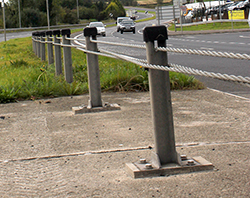 Northern Irelands Transport Minister Danny Kennedy – Department for Regional Development (DRD) – has announced the appointment of a contractor for the A26 dualling scheme which includes the section of the famous “Frosses Trees”.
Northern Irelands Transport Minister Danny Kennedy – Department for Regional Development (DRD) – has announced the appointment of a contractor for the A26 dualling scheme which includes the section of the famous “Frosses Trees”.
For riders will this see the fitting of wire-rope barrier restraint system along this new eight kilometre stretch of new dual carriageway between Glarryford and the A44 Drones Road Junction.
Already at Right To Ride we along with the British Motorcyclists Federation (BMF and the Motorcycle Action Group (MAG), politicians and individual riders have voiced concerns over the continued fitting of these “rider negative” restraint systems especially around their fitting on the A8 Larne Line dualling scheme.
Why Are We Concerned?
Taking two quotes from a raft of documentation on these systems – riders see this system as the most aggressive system when impacted by a rider and motorcycle compared to other restraint systems.
A study by DEKRA (Germany) and the University of Monash (Australia) carried out in 2005 contradicts this position and stated that:
“In all simulations the motorcycle slides along the wires until it hits a post, squeezing and trapping the rider’s leg against the wires as it does so. The post contact causes the motorcycle’s front wheel to snag lifting the front of the motorcycle up and throwing the rider’s torso and head forward.”
“Because the rider’s leg is trapped between the motorcycle and the wire ropes and the foot snags in the ropes, the head and torso slap into the front of the rising motorcycle. Eventually the leg becomes free as the motorcycle rotates and the rider is then catapulted over the barrier”
FEMA the Federation of European Motorcyclists’ Federation has stated in its “The Road To Success” document that, “Motorcyclists in general consider cable barriers to be the most dangerous of all existing Vehicle Restraint Systems. The exposed supporting posts stand so close together that post accident, a rider would inevitably collide with one or more of the posts which are frequently sharp edged.”
Meeting With Minister
The successful consortium awarded the bid for the scheme is the BAM/McCann is different than those working on the A8 Larne Line but the concerns are that with work expected to start by the end of this year, running for a period of 28 months, with completion expected in early to mid 2017 than there will be another line of wire rope barriers that puts riders at risk as they implant themselves without consideration by consortiums and our Roads Agencies their Departments.
However some light is a forth coming meeting with Minister Kennedy at Parliament Buildings Stormont to discuss riders concerns.
In England recently this has led to organised demonstrations against the fitting of wire rope system by the A11 Riders Action Group on the A11 dualling scheme between, Thetford and Barton Mills in Norfolk. The group is also looking to take their demonstrations, petitions and lobbying of politicians, ministers and road authorities to the heart of the Westminster Parliament in London.
While in Northern Ireland we seem to be at the start of our active journey against wire rope systems, individual riders are more terse and of the opinion that what will it take a rider to die before anything is done!
Original Source DRD – Click Here
Information
The preferred route for the A26 scheme was announced on 11 August 2008. The Statutory Orders for the scheme were published on the 19 November 2013 and became operative in January 2014.
The A26 website is available to update the public on progress of the scheme which can be viewed on the DRD NI website – Click Here
A11 Riders Action Group – On Facebook
Rider hits cable barrier without protection
Rider hits cable barrier without protection
Rider hits cable barrier with protection



Speak Your Mind